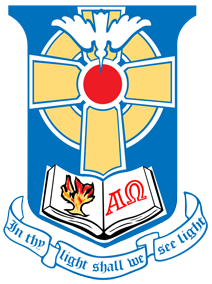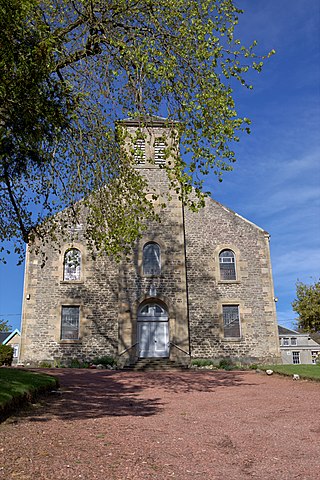Related Research Articles

Adam Gib was a Scottish religious leader, head of the Antiburgher section of the Scottish Secession Church. He reportedly wrote his first covenant with God in the blood of his own veins. Gib was born in the parish of Muckhart, in southern Perthshire on 15 April 1714.

Ebenezer Erskine was a Scottish minister whose actions led to the establishment of the Secession Church.

The Associate Reformed Presbyterian Church (ARPC) is a theologically conservative denomination in North America. The ARPC was formed by the merger of the Associate Presbytery (seceder) with the Reformed Presbytery (covenanter) in 1782. It is one of the oldest conservative denominations in the United States.

The Anti-Burghers were opponents of the Burgher Oath on theological grounds.

Thomas M'Crie was a Scottish biographer and ecclesiastical historian, writer, and preacher born in the town of Duns, and educated at the University of Edinburgh. He became the leading minister of the Original Secession Church. His work: "Life of Knox" (1813) was a means of vindicating the Scottish reformer John Knox who was a unpopular figure at the time. It was followed by a "Life of Andrew Melville" (1819). Melville was Knox's successor as the leader of the Reformers in Scotland. M'Crie also published histories of the Reformation in Italy and Spain. He received an honorary degree of D.D. in 1813, the first Secession minister to receive such an award.

Thomas M'Crie was a Presbyterian minister and church historian. He was a Scottish Secession minister who joined the Free Church of Scotland and served as the Moderator of the General Assembly to that church 1856/57.

Abbeygreen Church is a congregation of the Free Church of Scotland in the small town of Lesmahagow, Lanarkshire. As a Christian congregation, it is presbyterian and reformed; holding the Word of God, the Holy Bible, as the supreme rule of life and doctrine and as a subordinate standard, the Westminster Confession of Faith which helps explain the doctrines of the Christian faith. Being Presbyterian, it serves as part of the Free Church of Scotland Presbytery of Glasgow and seeks to faithfully serve God in Lesmahagow and the surrounding area. Having a missional outlook it is involved with a number of missionary organizations including, but not only, UFM Worldwide and Rose of Sharon Ministries, and helps with the organization and support of the Scottish Reformed Conference.

Henry Cooke (1788–1868) was an Irish Presbyterian minister, an opponent of secularisation, and, in response to Catholic mobilisation under Daniel O'Connell, an advocate of "Protestant unity".
Ralph Robb was a Scottish clergyman, the first Free Church of Scotland minister in the New World.

The First Secession was an exodus of ministers and members from the Church of Scotland in 1733. Those who took part formed the Associate Presbytery and later the United Secession Church. They were often referred to as Seceders.

The Reformed Presbyterian Church of Scotland is a small, Scottish, Presbyterian church denomination. Theologically they are similar to many other Presbyterian denominations in that their office-bearers subscribe to the Westminster Confession of Faith. In practice, they are more theologically conservative than most Scottish Presbyterians and maintain a very traditional form of worship. In 1690, after the Revolution, Alexander Shields joined the Church of Scotland, and was received along with two other ministers. These had previously ministered to a group of dissenters of the United Societies at a time when unlicensed meetings were outlawed. Unlike these ministers, some Presbyterians did not join the reconstituted Church of Scotland. From these roots the Reformed Presbyterian Church of Scotland was formed. It grew until there were congregations in several countries. In 1876 the majority of Reformed Presbyterians, or RPs, joined the Free Church of Scotland, and thus the present-day church, which remained outside this union, is a continuing church. There are currently Scottish RP congregations in Airdrie, Stranraer, Stornoway, Glasgow, and North Edinburgh. Internationally they form part of the Reformed Presbyterian Communion.

The Presbyterian Church in Ireland is the largest Presbyterian denomination in the Republic of Ireland, and the largest Protestant denomination in Northern Ireland. Like most Christian churches in Ireland, it is organised on an all-island basis, in both Northern Ireland and the Republic of Ireland. The church has approximately 210,000 members.

James Fisher (1697–1775) was one of the founders of the Scottish Secession church. He was born at Barr, on 23 January 1697, the second son of Thomas Fisher, minister of Rhynd. He was educated at University of Glasgow. He was licensed by the Presbytery of Perth on 31 October 1722 and subsequently called and ordained on 23 December 1725. He dissented and joined with his father-in-law Ebenezer Erskine in his appeal and complaint to the Assembly of 1733. He was one of the four original members of the Associate Presbytery founded at Gairney Bridge on 6 December 1733. He was deposed by the General Assembly on 15 May 1740, but continued to preach in the parish church till 13 August 1741, when he was forcibly ejected on a sheriff's warrant. He then preached in a tent on Kinclaven brae during the time he remained in the district. On 8 October 1741 he became minister of Shuttle Street Associate Congregation, Glasgow. He was deposed by the Associate (Antiburgher) Synod on 4 August 1748 over the question of the Burgess Oath. He was appointed Professor of Divinity by the Associate (Burgher) Synod in 1749. He died on 28 September 1775.
The (General) Synod of Ulster was the forerunner of the General Assembly of the Presbyterian Church in Ireland. It comprised all the clergy of the church elected by their respective local presbyteries and a section of the laity. Official records of its proceedings exist from 1691.

Presbyterianism has had a presence in the United States since colonial times and has exerted an important influence over broader American religion and culture.
In the Scottish church of the 18th and 19th centuries, a burgher was a person who upheld the lawfulness of the Burgher Oath.

George Paxton was a Scottish secession minister and poet. He was the professor of divinity of the 'New Licht' Anti-Burgher General Associate Synod.
Patrick Hutchison (1741–1802) was a Presbyterian minister who produced the first systematic definition of the beliefs of the Relief Church in Scotland.
Thomas Nairn was a controversial Scottish Presbyterian minister. Although he served in several Presbyterian denominations perhaps his most important contribution to church history was his role in setting up the organisation which eventually became the Reformed Presbyterian Church. Although his stay with that religious community was relatively short he was acknowledged, by right of his valid ordination, to have the authority, along with John M'Millan, to form a legitimate presbytery and in so doing to be able to ordain others to the offices of the church. Before Nairn's arrival M'Millan had for more than 36 years been the only minister in what was essentially a small denomination known as the United Societies. Nairn had previously been a minister in the Associate Presbytery of the First Seceders, although he started and ended his days in the Church of Scotland.

Bristo Church was a Presbyterian church located in the Bristo area of Edinburgh, Scotland. Founded in 1741 as a Secession church, it reunited with the Church of Scotland in 1929 before being dissolved in 1937. The University of Edinburgh afterwards used the building as the Pollock Memorial Hall until its demolition in 1967.
References
- ↑ Christian Study Library, 150th Anniversary of the General Assembly in Ireland
- 1 2 3 4 UK Wells website, Church in N Ireland
- 1 2 Discover Ulster Scots website, The Story of the Presbyterians in Ulster
- ↑ Lisburn.com website, The Church in the Rolling Hills
- ↑ Presbyterian History Ireland website, The Last of the Seceders
- ↑ Audio Sermon website, Robert Murray Mc’Cheyne – Days of Revival 129
- ↑ Google Books website, Memoir and Remains of the Rev. Robert Murray McCheyne, by Robert Murray M'Cheyne, Andrew Alexander Bonar